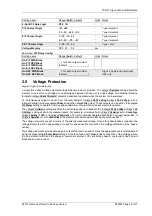
7SG11 Argus Technical Reference
©2013 Siemens Protection Devices Limited
P20007 Page 39 of 71
The protection applied for Line Check Trip can be set independently for P/F, E/F, SEF/REF and/or SA, to either
INST
(Instantaneous Lowset) or to
DELAYED
(D HS1 + HS2), by the relevant
Auto-reclose:
Line CheckTrip
settings.
An example of this setting’s use is that after a lockout state is reached the user can set Line Check Trip to
OFF
so
that when the Circuit Breaker is then manually closed onto a permanent fault the relay is forced to go through an
auto reclosing sequence to ensure that sectionalising/grading occurs to isolate a permanently faulted section of
the system. After successful isolation
Auto-reclose:
Line Check Trip
should be set back to
ON.
P/F ARC = IN/OUT
Auto-reclose:
P/F ARC
setting,
If set to
IN
(on) the relay will perform a full Phase Fault AutoReclose sequence,
If set to
OUT
(off) the relay will perform a one Trip to Lockout sequence applying the first programmed protection
trip characteristic unless this is overridden by any applied inhibit controls.
The first protection trip characteristic in a sequence will typically be set to
INST
i.e. Instantaneous Lowset,
therefore, if
P/F ARC
is set to
OUT
(off) the relay will not grade with other Protections in the system to isolate a
permanent fault. However, the relay can be re-configured to perform one delayed Trip to Lockout by raising
P/F
Lowset Inhib.
, preventing the Instantaneous Lowset from operating, thus allowing the IDMT Characteristic etc. to
grade.
P/F Lowset can be Inhibited by a raised status input mapped in
Status Config.:
P/F Lowset Inhib.
, or
P/F INST ON/OFF
can be set via the communications link commands. All
Inst. Lowset ON/OFF
may also be set via the relay’s
Linesman
Mode:
Inst. Lowset ON/OFF
setting (see section 2.15)
or via a communications link
P/F Instantaneous ON/OFF
command.
Protection Trips 1 to 4
The Protection characteristic applied for each of the first four trips in a sequence can be user set to
INST
Instantaneous (LowSet) or composite d Hi HighSet2 characteristic, as specified by the
Auto-
reclose
P/F Protection Trip 1 (2)(3)(4)
settings. Any combination of inst (I) & Delayed (D) trips is allowed e.g. 2I + 2D, or
I+D+I+D, or 2D + 2I etc.. However, the fifth trip in any sequence, if allowed by the user, will always apply the
composite d HS1 + HS2 characteristic to attempt to retain as much of the system in service as possible.
The two highset elements can be applied as trip elements with the delayed characteristic to provide a composite
characteristic, or used as independent elements. The
Auto-reclose:
P/F HS1 Trips To Lockout
and
Auto-reclose:
P/F HS2
Trips To Lockout
settings may be set to limit the number of high current trips, or, if set to
1
to truncate a P/F
sequence to Lockout if the HS1 or HS2 fault level setting is exceeded.
Reclose Delay (Dead time) and Close Routine
The Reclose delay or line Dead Time, is basically the length of time the Circuit Breaker is open before being
reclosed. An auto reclose sequence may have more than one Reclose delay.
After the first and subsequent trips, when the Circuit Breaker has opened and all starters and External ARC Start
SA are cleared, the relay checks the reason for that Trip and determines its next state.
If the relay determines that it is not to go to Lockout but is to proceed to perform the next set step in the Auto-
Reclose sequence, the relay applies the Reclose Delay (dead time) specified by the
Auto-reclose:
P/F Reclose DTL [1]
[2] [3] [4]
settings, the Auto Reclose sequence commences and an ‘Arc Active’ event and alarm is raised, this may
be mapped by the user to an output relay as defined by the
O/P Relay Config.:
ARC Active
setting. The output remains
raised until the sequence has successfully reclaimed, or a lockout occurs, at which time the ‘Arc Active’ event and
alarm output is cleared.
After the Reclose Delay the relay enters the Reclose routine and checks that Reclose Block is not raised before
issuing a close pulse via the output relay output contacts specified by the
O/P Relay Config .:
Close Pulse
setting. Note:
If any ARC INHIBIT is raised before or at any time during a Reclose Delay or during the Reclose Block time the
relay will go to Lockout.
A raised status input mapped to
Status Config.:
Reclose Block
can be used to prevent autoreclosing if external
conditions do not allow an immediate close of the circuit breaker e.g. if a motor wound circuit breaker close spring
needs additional time to recharge or if the system is out of synchronism, etc. External blocking contacts can be
wired in parallel. If all the reclose block inputs are not cleared within the 5 second reclose-block time delay the
relay will go to Lockout. If all the reclose block inputs are cleared at any time within the 5 secs reclose-block time
delay then the close pulse will be issued, thus the autoreclose close pulse may be held back by up to 5 secs after
the end of the reclose delay.
The Close Pulse duration is set using the
Auto-reclose:
Close Pulse
setting. The close pulse will be truncated either
when the
Status Config.:
CB Open
and
Status Config.:
CB Closed
status inputs show that the CB has closed, or if the CB
closes onto a fault and any protection starter picks up. Thus the close pulse may be left set to the default of 2
seconds without racing conflicts being created. The relay will not issue a Close pulse to a closed CB.















































